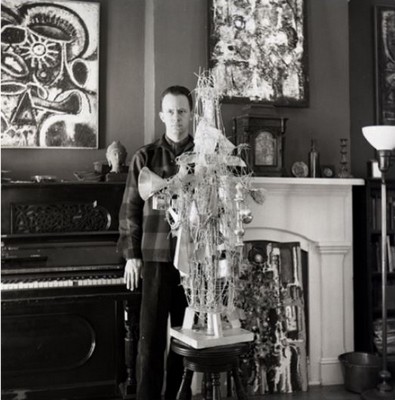Richard Pousette-Dart
1950s: Spirit and Substance
Pace Gallery, New York
November 11 – December 17, 2022
Eagle Valley Road, c. 1952-53
© The Richard Pousette-Dart Foundation
The presentation spotlights Richard Pousette-Dart’s paintings, sculptures, works on paper, and journals from the 1950s, a pivotal decade of the artist’s career during which he moved from New York City to Rockland County, located in the Lower Hudson River Valley of New York state. The works in Pace’s exhibition—which is curated by Joanna Pousette-Dart, the artist’s daughter— have never been shown together. Holistically, the presentation offers an unprecedented, in-depth look at a protean period in which Richard Pousette-Dart’s painterly investigations were directed toward the extremes of color, light, and physical density, further amplified by his multidisciplinary practice that included sculpture and photography. This exhibition presents seemingly dissimilar but deeply interconnected bodies of work, unified by their underlying structures and additive processes, to immerse viewers in the artist’s expansive vision.
The rich, varied works in Pace’s presentation, which diverge and converge in surprising ways, reflect the artist’s interest in cross-pollination among various mediums. These pieces also speak to the natural world’s profound influence on his artistic sensibility. Richard Pousette-Dart’s 1951 move to New York’s Rockland County, which freed him from the confines of his smaller studio in the city, had a liberating effect on his art. Working in a new, spacious environment, the artist followed his ideas to unexpected conclusions, allowing his thought processes to interact across canvas, sculpture, and paper.
While he is widely known as a first-generation Abstract Expressionist painter, Richard Pousette-Dart’s distinctive and richly inventive formal experimentations should be understood beyond that movement. Often exploring the spiritual and transcendental possibilities of art making through a personal philosophy and iconography of organic and biomorphic forms, Richard Pousette-Dart built on his innovations of the 1930s and 1940s to draw inspiration from the beauty, complexity, and wholeness of nature, continuing to expand his vision over the following four decades of his practice.
“Art for me is the heavens forever opening up, like asymmetrical, unpredictable, spontaneous Kaleidoscopes,” Richard Pousette-Dart said in his 1951 talk at the SMFA in Boston, which focuses on his artistic philosophy and working process. “It is magic, it is joy, it is gardens of surprise and miracle. It is energy, impulse. It is question and answer. It is transcendental reason. It is total in its spirit.”
The exhibition at Pace, which has represented the artist’s estate since 2013, brings together some of the most iconic paintings created by Richard Pousette-Dart during the 1950s, including loans from private collections as well as the Whitney Museum of American Art, the Museum of Modern Art, and the Brooklyn Museum in New York. These pieces are shown alongside his work in other mediums, providing a deep and nuanced look at the breadth of his practice.
The exhibition showcases a selection of the artist’s oneiric and ethereal White paintings—first shown at Betty Parsons Gallery in New York and later featured in the exhibition Pousette-Dart: Predominantly White Paintings at the Phillips Collection in Washington, D.C.—in which graphite lines are etched into layers of white, coalescing in intricate abstractions. These are shown in juxtaposition with Richard Pousette-Dart’s Gothic and Byzantine paintings, including the 1958 work Blood Wedding, to shed light on the artist’s investigations of intense color saturation and physicality. The wire and metal sculptures in the presentation, such as The Woman with a Horn (Wire Sculpture #4) (1951), are further manifestations of this cross-media conversation.
Archival materials in the exhibition call attention to the way Richard Pousette-Dart’s interest in photography informed his ideas about light and materiality. In addition to the paintings, wire sculptures, drawings, photographs, and notebooks on view in Pace’s exhibition, a group of pocket-sized brass sculptures contextualizes the featured works, underscoring the art historical richness of Richard Pousette-Dart’s bold output and bringing into focus his process of synthesizing varied structures, forms, and materials. Presented in their own vitrine, the artist’s hand-cut, geometric brass sculptures, which he introduced into his practice in the late 1930s, directly relate to the paintings in the exhibition. The semi-abstract forms from Richard Pousette-Dart’s brass works often figure in his works on canvas and paper, cultivating a sense of continuity across his practice.
Beyond Pace’s exhibition, Pousette-Dart’s artworks can be found in the collections of the Metropolitan Museum of Art, Solomon R. Guggenheim Museum, MoMA, and Whitney Museum in New York; the Los Angeles County Museum of Art; the San Francisco Museum of Modern Art; the National Gallery of Art and Hirshhorn Museum and Sculpture Garden in Washington, D.C.; the Peggy Guggenheim Collection in Venice; and other international institutions.
On the occasion of the exhibition, Pace Publishing produced a new catalogue featuring an interview between Joanna Pousette-Dart and curator Lowery Stokes Sims—who organized the Metropolitan Museum of Art in New York’s 1997 Pousette-Dart exhibition—as well as the text of a talk delivered by the artist at the School of the Museum of Fine Arts in Boston in 1951, published in its entirety for the first time.
RICHARD POUSETTE-DART (b. 1916, St. Paul, Minnesota; d. 1992, New York) is grouped with the first generation of Abstract Expressionist painters, although he took his own path throughout his long career, achieving a cohesive body of work with expressive form, color, and gesture. He participated in the pivotal Subjects of the Artists and Studio 35 groups, which were key to defining the New York School. Richard Pousette-Dart was the first of these artists to create a muralsized easel work (Symphony No. 1, The Transcendental, 1941–42, now at The Metropolitan Museum of Art, New York), prior to other Abstract Expressionists’ adoption of large formats. He drew inspiration from varied sources including Native American and Oceanic art, as well as Asian philosophy and American Transcendentalism. Never embracing action painting and instead pursuing his own aesthetic, Richard Pousette-Dart aspired to universal significance in his art, expressed through nonobjective means
PACE
510 West 25th Street, New York, NY 10001

